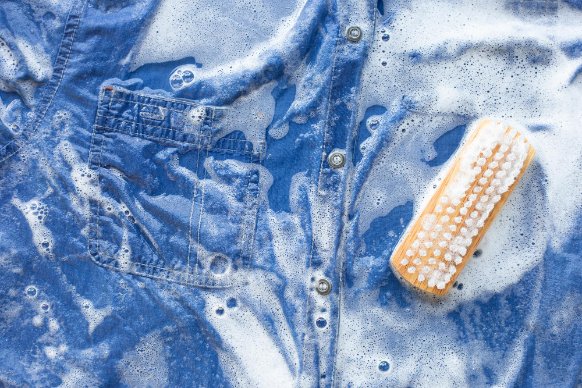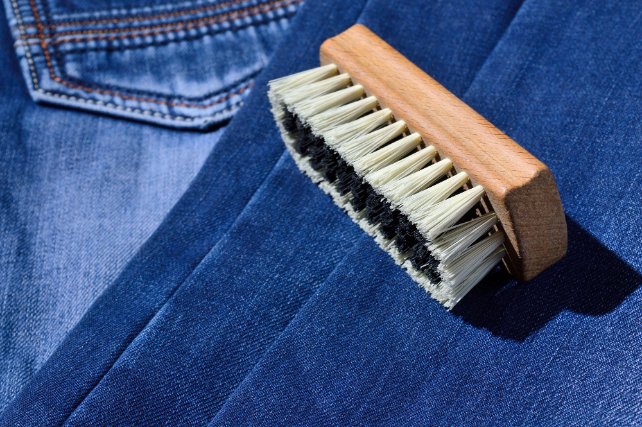Preserve your favorite jeans and denim pieces with expert techniques to maintain colour, fit, and fabric integrity
Denim fabric has been a wardrobe essential since the 1860s, when Levi Strauss transformed this sturdy material into the iconic blue jeans we know today. Its unique weave and robust nature make it one of the most versatile and long-lasting fabrics available.
Proper denim care involves washing in cold water, turning garments inside out before washing, and avoiding the tumble dryer to maintain the fabric’s integrity and prevent premature wear. Regular maintenance helps preserve the rich colour, perfect fit, and distinctive character that make denim items so special.
Taking care of denim doesn’t need to be complicated. With the right techniques, your favourite jeans and jackets can last for years while maintaining their shape and unique fade patterns that tell your personal story.
On This Page
Key Takeaways
- Wash denim inside out in cold water to preserve colour and prevent fading
- Air-dry denim items to maintain their shape and avoid fabric warping
- Spot clean stains promptly and store denim folded to prevent creasing
Understanding Denim Material
Denim fabric combines durability with unique characteristics that come from its distinctive twill weave pattern. The fabric’s construction and heritage make it one of the most versatile textile materials.
The History of Denim
Denim originated in Nîmes, France as ‘serge de Nîmes’. The name gradually evolved into the term ‘denim’ we use today.
The fabric gained popularity due to its exceptional strength and longevity. Its diagonal ribbing pattern emerged from a unique weaving technique that set it apart from other cotton materials.
Traditional denim production relied on shuttle looms, which created tightly woven edges known as selvedge. These edges prevented fraying and signified premium quality construction.
Types of Denim Fabric
Raw Denim: Untreated denim that develops unique wear patterns over time. This pure cotton variant requires minimal washing to maintain its character.
Selvedge Denim: Made on specialised shuttle looms, this type features tightly woven edges and superior durability. Its production method creates a denser, more uniform fabric.
Stretch Denim: A modern innovation that blends cotton with elastic fibres. This variant offers improved comfort and flexibility while maintaining denim’s classic appearance.
Standard denim uses a cotton twill weave, where weft threads pass under multiple warp threads. This technique creates the distinctive diagonal pattern visible on the fabric’s surface.
The Basics of Denim Care

Taking care of denim requires specific methods to maintain its quality and appearance. Good denim care habits help preserve the fabric’s colour, fit, and durability.
Washing Frequency
Washing denim less frequently helps maintain its shape and colour. Most denim items only need washing every 8-10 wears, unless they become visibly dirty or develop odours.
Spot cleaning is often enough to remove small stains. Use a damp cloth with mild soap to target specific areas without washing the entire garment.
For raw denim, waiting 6 months before the first wash helps create unique fade patterns and personal wear marks.
Choosing the Right Detergent
Gentle detergents designed for denim protect the fabric’s fibres and prevent colour loss. Choose liquid detergents over powder forms, as they dissolve more easily and are less likely to leave residue.
Always use cold water and avoid bleach or harsh cleaning agents. These can damage the indigo dye and weaken the cotton fibres.
Essential detergent tips:
- Use colour-preserving formulas
- Skip fabric softeners
- Select mild, pH-neutral options
- Measure detergent carefully to avoid residue build-up
Advanced Washing Techniques

Proper washing methods keep denim looking fresh while protecting the fabric’s durability and colour. The right technique depends on the denim type and desired results.
Hand-Washing Denim
Raw and selvedge denim requires gentle hand washing to maintain its character. Fill a basin with cold water and add a mild detergent designed for dark clothes.
Turn the denim inside out and submerge it completely in the water. Let it soak for 15-20 minutes without agitation.
Gently squeeze the fabric to remove dirt and oils. Never wring or twist the material, as this can damage the fibres and create uneven fading.
Between washes, one can keep denim fresh with a fabric refreshing spray.
Machine Washing Tips
Select a gentle cycle with cold water to protect the denim’s colour and structure. Use minimal detergent to prevent soap residue build-up.
Wash denim items separately to prevent the rough fabric from damaging other clothes. The indigo dye can also transfer to lighter garments.
Turn items inside out before washing. This protects the outer surface and allows better cleaning of areas that contact the skin.
Add a cup of white vinegar to the rinse cycle to:
- Remove odours
- Soften the fabric
- Set the dye
- Prevent colour bleeding
Drying and Ironing Denim

Taking proper care when drying and ironing denim helps maintain its shape, colour, and quality. The right techniques prevent damage and keep your denim looking fresh.
Proper Drying Methods
Hang drying denim is the best way to preserve the fabric. Turn items inside out and hang them by the hem to avoid unwanted creases.
Avoid tumble drying as it can cause shrinkage and damage to the fibres. If you must use a dryer, use the lowest heat setting and remove items while slightly damp.
For best results, dry denim away from direct sunlight to prevent fading. A well-ventilated space indoors works perfectly.
Ironing Tips for Denim
Steam works better than direct ironing for removing wrinkles from denim. Use a handheld steamer or hang items in the bathroom during a hot shower.
If you need to iron, follow these steps:
- Turn the garment inside out
- Use a low to medium heat setting
- Press gently to avoid creating shine marks
- Stop if you notice any glossy patches forming
Avoid using fabric softener when washing, as it can make ironing more difficult and affect the texture of your denim.
Maintaining Denim’s Shape and Colour
Proper care techniques help denim items keep their original fit and rich colour. Regular maintenance prevents common issues like fading, stretching, and shrinkage.
Preventing Fading
Wash denim garments inside out in cold water to protect the dye. Use a gentle detergent made specifically for dark clothing.
Never dry denim in direct sunlight, as UV rays break down the dye molecules. Instead, hang items to dry in a shaded area.
Iron or steam denim on the reverse side to prevent shine marks and preserve colour depth. Use medium heat to avoid damaging the fibres.
Avoiding Stretching and Shrinkage
Hang jeans properly by folding them lengthwise over a hanger rather than using clips or folding them on a shelf. This maintains the original shape through the leg.
Avoid washing denim too frequently. Clean items every 4-5 wears unless visibly soiled. Excessive washing can lead to fabric degradation and loss of shape.
Choose the correct drying method. Air drying helps prevent shrinkage, while brief tumble drying can restore the fit if jeans have stretched out.
Store denim flat or hung properly when not in use. Avoid cramming items into drawers where they can develop permanent creases.
Stain Removal and Repairs

Proper care of denim involves knowing how to tackle stubborn stains and fix minor damage to extend the life of the fabric. The right techniques and tools can make these tasks simple and effective.
Tackling Common Stains
Stain removal for denim starts with quick action. Apply stain remover directly to the affected area and gently work it into the fibres.
Oil stains need special attention. Blot the oil stain with a clean cloth instead of rubbing, which can make the problem worse.
Always use cold water for washing stained denim. Hot water can set stains permanently into the fabric.
For white fabrics with denim stains, apply stain-removing detergent and let it soak for 15-20 minutes before washing.
DIY Denim Repairs
Small tears can be fixed with iron-on patches applied to the inside of the garment. Press firmly with a hot iron for 30 seconds to secure the patch.
For frayed hems, trim loose threads and create a new hem using a double-fold technique. Use denim-specific needles and thread for the best results.
Reinforce weak areas, like pocket corners or belt loops, with a zigzag stitch before they tear completely. This preventive measure extends the life of the garment.
Storage and Preservation
The right storage methods help denim maintain its shape and prevent damage. Smart preservation techniques keep your denim looking fresh for years to come.
Proper Storage Techniques
Hanging denim properly prevents wrinkles and maintains shape. Fold jeans lengthwise and hang them over a sturdy hanger – never hang them by the belt loops.
For folded storage, lay denim flat in a drawer or on a shelf. Keep items neatly folded to avoid permanent creases.
Plastic containers can trap moisture and damage denim. Choose breathable cotton storage bags or boxes instead.
Long-Term Preservation Tips
Clean denim thoroughly before long-term storage to prevent stains from setting. Remove any accessories like buttons or pins that might leave marks.
Store denim in a cool, dry place away from direct sunlight. Sunlight can fade the fabric and weaken fibres.
Add cedar blocks or lavender sachets to storage areas. These natural items help repel moths and prevent musty odours.
Check stored denim every few months. Refold items to prevent permanent creases and ensure no moisture has accumulated.
Consider using acid-free tissue paper between folds for valuable or vintage pieces. This prevents colour transfer and reduces friction between layers.
Extending the Life of Denim Items

Proper care and maintenance of denim garments helps them stay in excellent condition and last for many years. The right cleaning and storage methods protect the fabric’s durability and appearance.
Caring for Denim Jeans
Wash denim jeans sparingly to maintain their shape and colour. Only clean them when they become visibly dirty or develop odours.
Turn jeans inside out before washing and use cold water with a mild detergent specifically made for denim. Skip the fabric softener as it can break down the fibres.
Hang jeans to air dry away from direct sunlight. The sun’s rays can cause fading and weaken the fabric.
Between washes, spot clean small stains with a damp cloth. Hanging jeans outside for fresh air can eliminate light odours without washing.
Special Considerations for Denim Jackets
Denim jackets need less frequent washing than jeans. A light brushing with a soft cloth removes surface dirt and dust.
Check all buttons, zips and seams regularly for loose threads or damage. Making small repairs quickly prevents bigger problems later.
Store jackets on sturdy hangers to maintain their shape. Leave space between garments to allow air circulation and prevent moisture buildup.
Clean jacket collars and cuffs more often, as these areas collect body oils and dirt. Use a soft brush with mild soap and water for spot cleaning.
Frequently Asked Questions
Taking proper care of denim helps maintain its durability and appearance. Specific washing, drying, and storage methods protect the fabric and prevent damage.
What is the best method to wash denim jeans for the first time?
Turn jeans inside out and soak them in cold water with a small amount of gentle detergent for 30 minutes. This helps set the dye and prevents excessive fading.
Hand wash gently without wringing or twisting the fabric. Rinse thoroughly with cold water until the water runs clear.
What guidelines should be followed when washing jeans in a washing machine?
Use a cold water setting and gentle cycle to protect the denim fabric’s durability. Turn jeans inside out and zip all zips, button all buttons, and empty all pockets.
Wash denim separately from other clothes to prevent colour transfer. Use a mild detergent specifically designed for dark colours.
What is the most suitable fabric softener to use on denim jeans?
Avoid fabric softeners completely as they can weaken denim fibres and affect the fabric’s natural characteristics. If softness is desired, add 120ml of white vinegar to the rinse cycle instead.
What is the recommended way to dry denim jeans after washing?
Air-dry jeans by hanging them from the waistband on a sturdy clothes hanger. Smooth out wrinkles and align the seams whilst damp.
Avoid tumble drying as heat can cause shrinkage and damage to the fabric structure. Direct sunlight may cause fading, so dry jeans in a shaded area.
How should I care for and maintain the quality of my denim jeans?
Clean spills and stains immediately using a damp cloth. Spot clean when possible instead of washing the entire garment.
Wash jeans only when necessary, typically after 4-5 wears. Frequent washing can cause unnecessary wear and fading.
What are the proper storage techniques for preserving denim in the long term?
Fold jeans neatly and store them in a cool, dry place away from direct sunlight. Avoid hanging jeans for long periods as this can distort their shape.
Leave space between items to allow air circulation. Cedar blocks or sachets can help absorb moisture and prevent musty odours.

